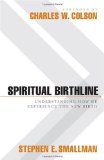Spiritual Birthline: Understanding How We Experience the New Birth. By Stephen E. Smallman. Wheaton, IL: Crossway Books, 2006. 171 pp. Paper. $12.99.
One of the endorsers explains well how Smallman arrived at his thesis: “By applying a pastor’s heart and a willing ear to hundreds of testimonies heard over decades of ministry, Stephen Smallman has distilled the work of God in the soul” (Mindy Belz, back cover).
Smallman’s thesis is that spiritual birth is like physical birth. Actual physical birth occurs nine months after conception, after physical life began. So too, he suggests, spiritual “birth,” or coming out, occurs some time after a spiritual life began. A chart on page 24 compares physical and spiritual birth. Conception in the physical realm corresponds to life beginning in the spiritual realm. Pregnancy corresponds to “effectual calling.” Delivery, a new baby crying, corresponds to conversion: faith and repentance. Physical growth of the baby corresponds to sanctification in the Christian life.
In the chart, the author suggests that “spiritual birth—regeneration” occurs over time between the beginning of spiritual life and the time of conversion.
But wouldn’t this make spiritual birth a process over time, and not something that occurs at a point in time? Yes: “The first thing to note from the birthline is the obvious fact that spiritual birth, just like physical birth, is fundamentally a process” (p. 25, italics his). “The process of coming to conscious faith, once the work of God has begun, is what could be thought of as spiritual pregnancy… In the older language of the Westminster Confession of Faith, the term for this is effectual calling, which simply means it works: when God calls, we come” (p. 27, italics his). “Spiritual pregnancy goes on as briefly or as long as it takes God to bring us to faith and repentance” (p. 27).
How long after spiritual life starts might conversion occur? The title of Chapter 2 gives the shocking answer: “The Birthline—A Sixty-five Year Pregnancy.” According to Smallman an Indian man in London came to faith in Christ sixty-five years after his spiritual life began (pp. 22-23)!
Frankly, this is very confusing. According to the author, spiritual life begins at a point in time. That starts a process called regeneration that lasts for years or decades. At the end of that time the process of regeneration has occurred.
While there is no condition of the new birth, according to the author, there are conditions for a person to “go public” (which Smallman also calls being converted). These include confessing Christ (pp. 16, 145), giving ourselves to Christ (p. 16), submitting one’s life to Christ (p. 78), confessing sin and receiving Christ as Lord and Savior (p. 80), trusting Christ as Lord and Savior (p. 16), repenting from sin and embracing Christ (p. 121), choosing to follow Christ (p. 126), and letting Jesus run our lives (pp. 147-49). What most Evangelicals would (wrongly) say are a variety of different ways to be born again, Smallman says are a variety of ways for a person who already possesses spiritual life to come out and finalize the process of regeneration.
Smallman repeatedly speaks of effectual calling (e.g., pp. 27, 77, 108, 130, 151). This calling is something which a person suspects, but can’t know with certainty (p. 149).
The most touching aspect of this book is that the author’s four children each give their own testimonies. These testimonies are well worth the price of the book. Each of the children look back over their lives and guess when they might have “gone public.” Since they believe that they were born again long before they went public, they clearly aren’t concerned about this coming out time. Listen to what Steve Smallman, Jr., himself a pastor, says: “Over the course of that summer God began to reveal to me, through a series of experiences, my profound spiritual bankruptcy and my real need for him to run my life. Was this my conversion? Possibly. But I have conscious recollection of my heart being warmed by sermons, songs, Christian fellowship, and the presence of God years before this time” (pp. 148-49).
Whenever we base our theology on our experience, or on the experience of others, we are in trouble. God has given us His Word, not experience, to show us the truth.
I strongly recommend this book to all discerning readers. It should be required reading for all soteriology classes.
Robert N. Wilkin
Editor
Journal of the Grace Evangelical Society
Irving, TX


